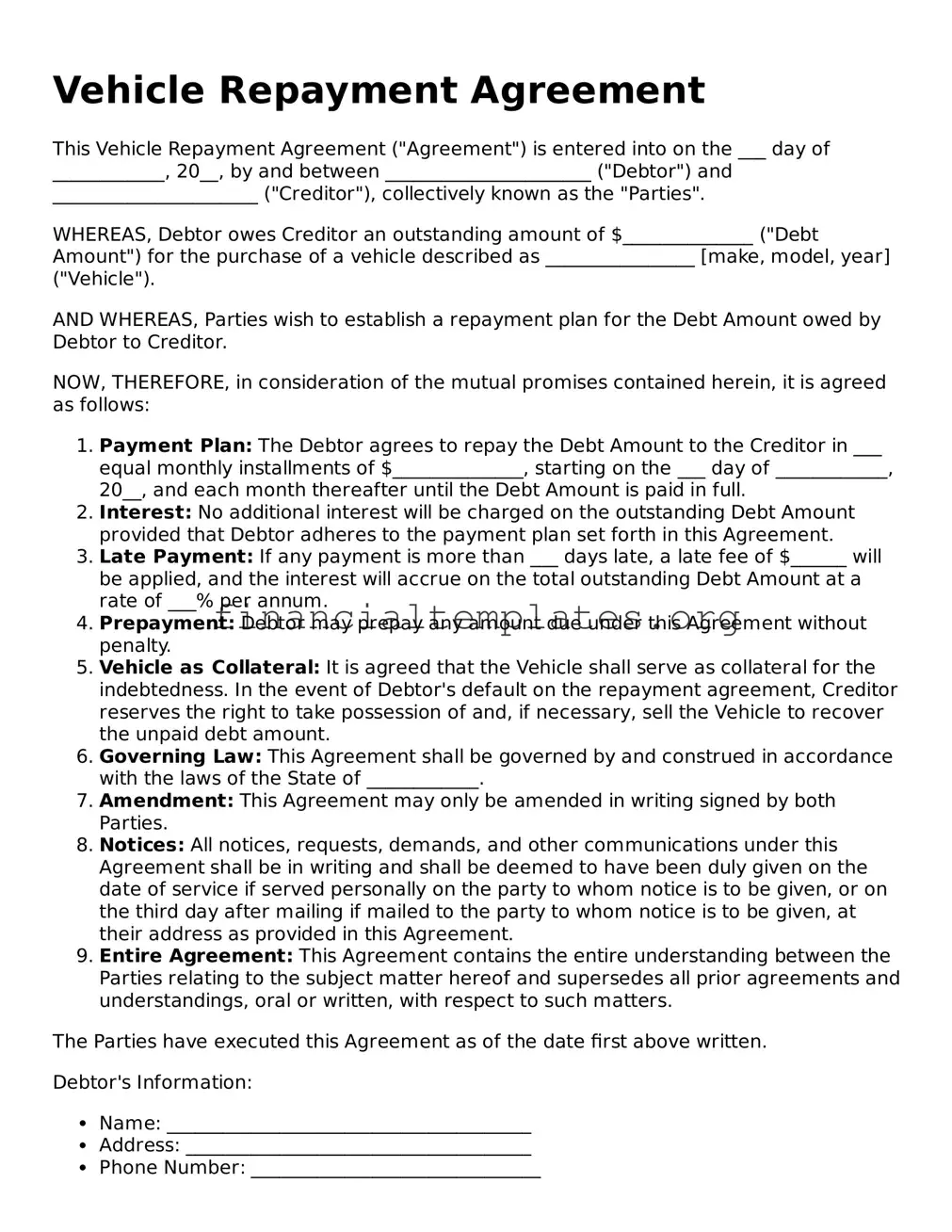The Vehicle Lease Agreement is similar to the Vehicle Repayment Agreement in that both pertain to the use of a vehicle under specific conditions. However, while the Vehicle Repayment Agreement focuses on the financial aspects and repayment terms for purchasing the vehicle, the Lease Agreement outlines the terms for renting the vehicle over a fixed period. Both documents establish the payment schedule, usage limits, and responsibilities of each party but differ in the end goal—ownership versus temporary use.
A Personal Loan Agreement shares similarities with the Vehicle Repayment Agreement as both are formal contracts that outline the terms of a loan and its repayment. They specify the loan amount, interest rate, repayment schedule, and the consequences of non-payment. However, the Personal Loan Agreement is broader and can be used for various purposes, not limited to the acquisition of a vehicle, making it more versatile.
The Installment Sale Agreement, much like the Vehicle Repayment Agreement, dictates the conditions under which an asset is sold and paid for in installments over a period. This agreement ensures that the ownership of the asset—often a vehicle—transfers to the buyer only after the full payment is made. Both documents protect the seller's interest by detailing the repayment terms and securing the asset until fully paid.
A Promissory Note is another document similar to the Vehicle Repayment Agreement as it represents a written promise to pay a specific sum of money to someone else under agreed terms. While Promissory Notes can cover various loans or debts, the Vehicle Repayment Agreement is specific to the financing of a vehicle. Both include details on repayment schedules, interest rates, and the consequences of defaulting.
The Mortgage Agreement shares common elements with the Vehicle Repayment Agreement since both involve a borrowing and lending arrangement secured by an asset. In the Mortgage Agreement, the property is used as collateral for the loan, just as a vehicle may secure the loan in a Vehicle Repayment Agreement. Each document lays out the terms of the loan, including repayment, interest, and actions in the event of non-payment, albeit for different types of property.
A Credit Sale Agreement is closely related to the Vehicle Repayment Agreement, focusing on the sale of goods on credit. This agreement typically involves payment in installments, similar to the repayment structure for a vehicle loan. Both parties agree on the terms of payment over time, interest rates, and the delivery of goods—in this case, a vehicle—prior to the final payment, with specifics tailored to the nature of the transaction.
The Conditional Sale Agreement bears resemblance to the Vehicle Repayment Agreement with its focus on the conditional transfer of ownership. The buyer does not receive full ownership of the vehicle until the terms of the agreement, usually including full repayment, are met. Both agreements protect the seller’s rights to reclaim the asset if the buyer fails to meet the agreed repayment conditions.
The Debt Settlement Agreement is somewhat similar to the Vehicle Repayment Agreement in the context of resolving an outstanding debt. This type of agreement usually comes into play when the debtor is unable to fulfill the original repayment terms and negotiates for a reduction or restructuring of the debt. Unlike the Vehicle Repayment Agreement, which is structured around regular payments for a vehicle, the Debt Settlement Agreement often involves negotiating to lower the debt amount and settle it with a lump sum payment or a new payment plan.
A Cosigner Agreement, which can accompany a Vehicle Repayment Agreement, involves a third party agreeing to take responsibility for the debt if the original borrower fails to pay. This agreement adds a layer of security for the lender, akin to the primary repayment agreement but specifically outlines the responsibilities and obligations of the cosigner, not the primary borrower. While it relates directly to the repayment of the vehicle, its focus is on ensuring an additional form of guarantee for the loan.
